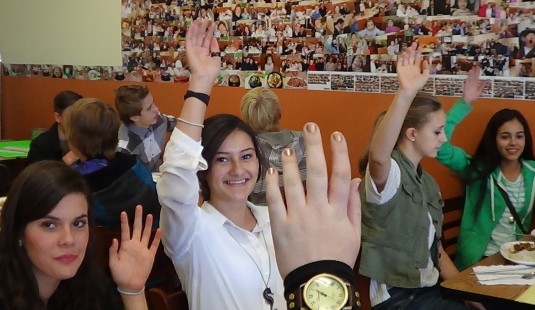Month: March 2015
Sustainable Education Through International Understanding
“When one country has an issue, it becomes the whole world’s issue. We as a planet have to try and make a change, because there is only one earth, which happens to be our only home… The small things affect the most, so definitely, I will do small things to save and conserve our planet.”
That’s a quote from one of the students, in the ESD: Sustainable Education Through International Understanding program, after collaborating internationally with Japanese students. It exemplified what the educators at Lakeridge Jr. High School were setting out to accomplish with this program.
Students Learn About Sustainable Education and How It Impacts the World

In an increasingly interconnected and globalized world the butterfly effect takes on new meaning. Emission problems in one country don’t just affect them; they affect all the surrounding countries and some that are not so close. As the rainforest is depleted we lose a global source of oxygen. When radiation leaks into the ocean, everything from algae to people are affected. Creating an awareness of global issues and sustainability is a necessary part of surviving in the modern world.
As Americans we often find ourselves a bit self-centered when it comes to world issues, but now that we can communicate across oceans with the click of a button, that distance has shrunk immeasurably and we can no longer afford to only think of ourselves.
How are 9th grade students in Orem, Utah learning about global issues through sustainability?
According to the initial proposal, submitted by Merida Davis’ team at Lakeridge Jr. High School, “Our goals are to stimulate and facilitate responsible sustainability awareness and interaction at the individual, community and global scales.” Their goal was to be realized by creating cross-curricular partnerships between the science department and the other subject instructors, initially in a professional development workshop. By creating this cross pollination of subjects teachers learned to “seamlessly incorporate sustainability into their subjects… and […] new perspectives on teaching their own subject area.” After this initial work with the educators was completed, the project moved on to address the students directly.

To become well versed in sustainability, students participated in sustainability-based community service projects. Part of those projects were about creating a documentary movie to highlight local issues, such as pollution, agriculture, climate change, resource management and depletion. Along with this, they also collaborated with Japanese students, giving them a perspective on this subject that they wouldn’t get otherwise.
WATCH: ESD Student Videos at VPD Awards
This project includes plans to offer a Sustainability Fair where students will celebrate their work by sharing their service and other sustainability-based projects. The Fair will culminate with a student film festival showcasing their work from throughout the school year.
Is this project something other teachers can replicate?
While now the primary benefits go to those students and educators directly involved with the program, it is the hope with future funding that they will be able to create online archives of lessons, produced videos, and other student work to serve as an outline for educators to adapt the program to their own schools needs.
Though the bulk of the cost goes into covering the teachers training, the best part about this model is once that initial hurdle is cleared it becomes increasingly easier year after year to teach this program.
How has the project evolved?
Through the lessons learned the projects accomplished in the last year, the educators have a better grasp on how to replicate the program in other classrooms more efficiently. Being able to replicate the program will enable them to broaden their scope in the coming year.

Through the grant they’ve been also able to fund Pen Pal letters to Toyoda Jr. High School in Japan. The exchange went beyond traditional pen pal relationships in that they were also able to chat electronically with students in Japan and Pakistan. A few students started learning basic Korean which resulted in a field trip to a Korean restaurant for many of the students first encounter with that culture’s cuisine. As a result of these opportunities, exchanges have also begun over Skype with students in Korea.

All of these things are creating students with a wider worldview and a greater connection to a global society. Through building relationships between teachers, offering meaningful exchange opportunities to students and by taking time to integrate curriculum, the ESD team has made sustainability education a reality for their students.

